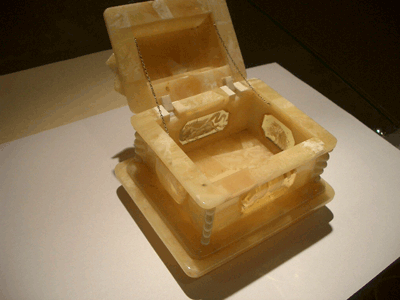Natural Plastic Jewelry - Amber, Horn and Tortoiseshell
 When we think of plastic jewelry, the first thing that comes to mind is colorful molded pieces of bakelite, acrylic or clear lucite plastics.
When we think of plastic jewelry, the first thing that comes to mind is colorful molded pieces of bakelite, acrylic or clear lucite plastics.Long before man-made plastics were invented, jewelry was being made of natural plastics - materials that could be heated, softened, molded, carved or pressed into many designs.
 One of the earliest natural plastics to be used for jewelry was Amber. Fossilized tree resin, not sap, amber is 30 to 50 million years old, and is often called "The Gold of the North", since much amber was found in the northern Baltic states and in Poland.
One of the earliest natural plastics to be used for jewelry was Amber. Fossilized tree resin, not sap, amber is 30 to 50 million years old, and is often called "The Gold of the North", since much amber was found in the northern Baltic states and in Poland.Amber's color ranges from a warm pale yellow, to the familiar honey-gold, to almost black. Clear amber is highly prized, and opaque amber lends itself to intricate carvings and shapes. Some amber jewelry can be found with pre-historic insects embedded inside. Amber lends itself to beautiful beads, pendants, earrings and rings. Beginning in the 1920s and 1930s, amber was imitated by less expensive synthetic plastics such as bakelite and celluloid. To test for amber, you could heat a pin and insert it into an inconspicuous part of the piece. The pin should go in easily. It's better to have a professional non-invasive test performed by a jeweler.
Amber jewelry is plentiful, and can be found at reasonable prices. It pairs beautifully with silver, and the golden color complements any complexion.
Horn and Tortoiseshell have been made into jewelry since ancient times. Natural horn from buffaloes and other animals was ground up, pressed into molds and heated to form boxes, buttons, hair combs and jewelry pieces such as pins and brooches. Natural horn has an uneven, crackled surface, and feels hollow. If burned, it smolders and has an odor like burned hair. Again, a professional opinion is preferred to possibly damaging a vintage piece of horn jewelry.
Tortoiseshell, familiar in its synthetic form as eyeglass frames, is actually made from the shells of Hawksbill turtles. It was used to make boxes, hair combs and jewelry in the late nineteenth century. Real tortoiseshell has an irregular natural grain, will burn with a flame and has the odor of burned hair.
 If you have the opportunity to purchase jewelry pieces made of amber, horn or tortoiseshell, be sure that you are getting the genuine article and not a synthetic plastic imitation. Deal only with reputable sellers, and ask for a written guarantee that you are getting the real thing. Have the piece tested by a professional, and care for it as you would any piece of fine jewelry. Keep it clean, wipe it with a soft cloth after each wearing, and store it carefully. ( By Deena O'Daniel )
If you have the opportunity to purchase jewelry pieces made of amber, horn or tortoiseshell, be sure that you are getting the genuine article and not a synthetic plastic imitation. Deal only with reputable sellers, and ask for a written guarantee that you are getting the real thing. Have the piece tested by a professional, and care for it as you would any piece of fine jewelry. Keep it clean, wipe it with a soft cloth after each wearing, and store it carefully. ( By Deena O'Daniel )

0 komentar:
Posting Komentar